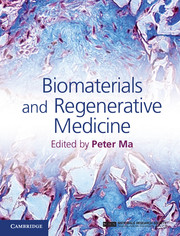Book contents
- Frontmatter
- Contents
- List of contributors
- Preface
- Part I Introduction to stem cells and regenerative medicine
- 1 Embryonic stem cells
- 2 Induced pluripotent stem cells
- 3 Connective tissue stem and progenitor cells
- 4 Hematopoietic stem cells and their niches
- 5 Using biomaterials for fetal stem cell isolation, expansion and directed-differentiation
- 6 The hematopoietic stem cell niche
- Part II Porous scaffolds for regenerative medicine
- Part III Hydrogel scaffolds for regenerative medicine
- Part IV Biological factor delivery
- Part V Animal models and clinical applications
- Index
- References
1 - Embryonic stem cells
from Part I - Introduction to stem cells and regenerative medicine
Published online by Cambridge University Press: 05 February 2015
- Frontmatter
- Contents
- List of contributors
- Preface
- Part I Introduction to stem cells and regenerative medicine
- 1 Embryonic stem cells
- 2 Induced pluripotent stem cells
- 3 Connective tissue stem and progenitor cells
- 4 Hematopoietic stem cells and their niches
- 5 Using biomaterials for fetal stem cell isolation, expansion and directed-differentiation
- 6 The hematopoietic stem cell niche
- Part II Porous scaffolds for regenerative medicine
- Part III Hydrogel scaffolds for regenerative medicine
- Part IV Biological factor delivery
- Part V Animal models and clinical applications
- Index
- References
Summary
Preimplantation embryo development sets the stage for pluripotency
Regenerative medicine has the potential to revolutionize health care by offering the promise of replacement cells, tissues, and organs to combat injury, disease, and aging. In an ideal setting, stem cell therapies would begin with a pluripotent cell that by definition is able to give rise to any cell formed in the embryo. Additionally this would most likely require that the stem cells could self-renew or were able to divide and give rise to either more pluripotent stem cells or progressively more differentiated cells under the control of extrinsic cues. Stem cells are biological cells found in multicellular organisms, that can mitotically divide and differentiate into specialized cell types and can self-renew to produce more stem cells. There are two broad types of stem cells: embryonic stem cells and adult stem cells. Embryonic stem cells originate from the inner cell mass of the preimplantation embryo and are considered pluripotent whereas in situ adult stem cells are considered multipotent. Embryonic stem cells (ESCs) possess characteristics that make them a potentially outstanding starting material for use in regenerative medicine. They are unique among cultured cells because they have an apparently limitless capacity to self-renew in vitro, as well as being pluripotent. Because of these extraordinary properties, ESCs have been an intense focus of research for more than 30 years.
- Type
- Chapter
- Information
- Biomaterials and Regenerative Medicine , pp. 3 - 18Publisher: Cambridge University PressPrint publication year: 2014



